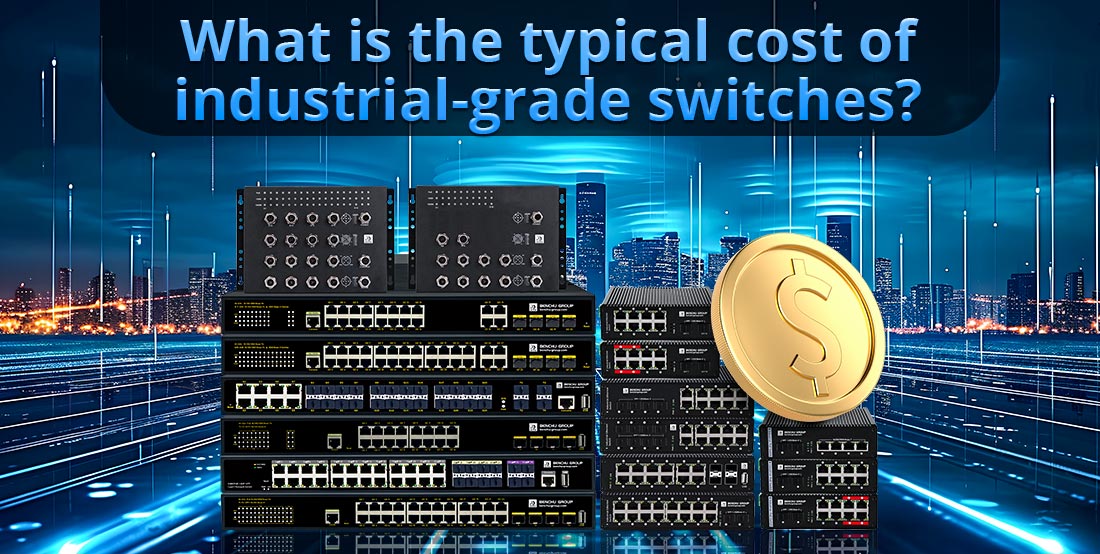
The cost of industrial-grade switches can vary widely based on several factors, such as the number of ports, port types (Ethernet, fiber, PoE), data speed (Fast Ethernet, Gigabit, or 10 Gigabit), ruggedness, and additional features like redundancy, security protocols, or management capabilities.Here’s a detailed breakdown of the factors influencing the cost and typical price ranges of industrial-grade switches:
1. Cost Factors
a. Port Count
--- 4 to 8-Port Industrial Switches: Smaller switches with fewer ports tend to be the most affordable. Prices typically range from $100 to $600 depending on features like management capabilities, PoE, and ruggedization.
--- 8 to 24-Port Industrial Switches: These medium-sized switches generally cost more due to the increased number of ports. Prices can range from $400 to $1,500, depending on the switch's functionality and environmental durability.
--- 24 to 48-Port Industrial Switches: Larger switches intended for more complex networks or core infrastructure can be priced anywhere from $1,200 to over $5,000, particularly if they include advanced management features and higher port speeds.
b. Management Type
--- Unmanaged Switches: These are simple plug-and-play devices without advanced network configuration options. They are more affordable, typically ranging from $100 to $800, depending on the number of ports and environmental ratings.
--- Managed Switches: These switches allow for configuration, monitoring, and control of the network, making them suitable for more complex setups. Managed switches are more expensive, with prices ranging from $400 to $3,000 or more, depending on the features offered, such as VLAN support, redundancy protocols, or security mechanisms.
c. Port Speed
--- Fast Ethernet (10/100 Mbps): Switches that support standard Fast Ethernet are typically on the lower end of the price scale. A 4 to 8-port Fast Ethernet switch could cost between $100 and $400, while larger Fast Ethernet switches with 16 or more ports might range from $300 to $1,000.
--- Gigabit Ethernet (10/100/1000 Mbps): Switches that support Gigabit Ethernet are now more common in industrial environments, providing faster speeds and higher performance. Prices for Gigabit Ethernet switches generally range from $300 to $2,500 depending on the number of ports and other features.
--- 10-Gigabit Ethernet (10GbE): For industries requiring extremely high bandwidth, 10GbE switches are used. These are typically more expensive, with costs ranging from $1,500 to over $5,000 depending on port count and features.
d. PoE (Power over Ethernet) Capabilities
--- Non-PoE Switches: These are more affordable since they only handle data transmission. A non-PoE switch with 8 to 24 ports may range from $200 to $1,200.
--- PoE Switches: PoE switches, which provide power to connected devices like IP cameras, wireless access points, or industrial sensors, tend to be more expensive. Prices can range from $400 to $2,500, depending on the number of ports and the power delivery standards (e.g., PoE or PoE+).
e. Environmental Durability (Ruggedization)
--- Standard Industrial-Grade Switches: These are suitable for moderately harsh environments and have features like extended temperature ranges (-10°C to 60°C), vibration resistance, and basic dust protection. Costs typically range from $300 to $1,500, depending on the port count and other features.
--- Hardened/Rugged Switches: These switches are designed for extreme environments (e.g., mining, oil and gas, heavy manufacturing), offering extended temperature support (-40°C to 75°C), protection against moisture, dust, and electromagnetic interference (EMI). Prices for these switches can start at $700 and go up to $5,000 or more, depending on the port count and other advanced features.
f. Additional Features
--- Redundancy & High Availability Features: Industrial switches with features like dual power supplies, ring topology support (e.g., Rapid Spanning Tree Protocol or Ethernet Ring Protection Switching), and network recovery mechanisms typically cost more. These can range from $1,000 to over $5,000, especially if used in mission-critical applications.
--- Security & Network Protocols: Managed industrial switches with advanced security features (e.g., IP filtering, firewall capabilities, or VPN support) and support for advanced network protocols like QoS (Quality of Service), SNMP (Simple Network Management Protocol), or LLDP (Link Layer Discovery Protocol) tend to cost more.
2. Typical Price Ranges
| Switch Type | Port Count | Price Range |
| Unmanaged Industrial Switch | 4-8 ports | $100 - $600 |
| Unmanaged Industrial Switch | 8-24 ports | $300 - $1,200 |
| Managed Industrial Switch | 4-8 ports | $300 - $1,000 |
| Managed Industrial Switch | 8-24 ports | $500 - $2,500 |
| PoE Industrial Switch | 8-24 ports | $400 - $2,500 |
| Ruggedized Switch | 8-24 ports | $700 - $5,000+ |
| 10GbE Industrial Switch | 8-48 ports | $1,500 - $5,000+ |
3. Application-Specific Pricing
Factory Automation: Typically requires rugged switches with high port counts (12-24) and advanced management. Costs range from $800 to $3,500.
Surveillance Systems: Often use PoE switches to power IP cameras, with prices ranging from $400 to $2,000 depending on the number of cameras supported.
Smart Cities: For outdoor deployments, ruggedized switches with fiber optic support and PoE for sensors and cameras may cost between $1,500 and $4,000.
4. Long-Term Cost Considerations
Reliability and Durability: Industrial switches are built to last in challenging conditions, which can result in fewer replacements or repairs, potentially lowering long-term costs.
Maintenance and Support: Managed switches may incur additional costs for setup, monitoring, and ongoing maintenance, which can increase the total cost of ownership.
Energy Efficiency: Some switches are designed to be more energy-efficient, which can reduce operational costs over time.
Conclusion
The typical cost of an industrial-grade switch can range from $100 to over $5,000, depending on factors like port count, speed, PoE capabilities, environmental requirements, and advanced network management features. When selecting an industrial switch, it’s essential to balance upfront costs with the long-term benefits of reliability, scalability, and support for the specific industrial application.